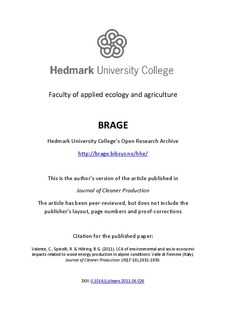| dc.contributor.author | Valente, Clara | |
| dc.contributor.author | Spinelli, Raffaele | |
| dc.contributor.author | Hillring, Bengt G. | |
| dc.date.accessioned | 2012-01-31T14:20:41Z | |
| dc.date.available | 2012-01-31T14:20:41Z | |
| dc.date.issued | 2011 | |
| dc.identifier.citation | Valente, C., Spinelli, R. & Hillring, B.G. (2011). LCA of environmental and socio-economic impacts related to wood energy production in alpine conditions: Valle di Fiemme (Italy). Journal of Cleaner Production 19(17-18),1931-1938. | no_NO |
| dc.identifier.uri | http://hdl.handle.net/11250/134332 | |
| dc.description | This is the postprint version of the article. The published version of the article you can find here: http://www.sciencedirect.com/science/article/pii/S0959652611002381 | no_NO |
| dc.description.abstract | An extended Life Cycle Assessment (LCA) is performed for evaluating the impacts of a woody biomass supply chain for heating plants in the alpine region. Three main aspects of sustainability are assessed: greenhouse gas emissions, represented by global warming potential (GWP) impact category, costs and direct employment potential. We investigate a whole tree system (innovative logging system) where the harvest of logging residues is integrated into the harvest of conventional wood products. The case study is performed in Valle di Fiemme in Trentino region (North Italy) and includes theoretical and practical elements. The system boundary is the alpine forest fuel system, from logging operations at the forest stand to combustion of woody biofuels at the heating plant. The functional unit is 1 m3 solid over bark of woody biomass, delivered to the district heating plant in Cavalese (Trento). The relative sustainability of traditional and innovative systems is compared and energy use is estimated. Results show that the overall GWP and costs are about 13 kg CO2equivalent and 42 euro per functional unit respectively for the innovative system. Along the product supply chain, chipping contributes the greatest share of GWP and energy use, while extraction by yarder has the highest financial costs. The GWP is reduced by 2.3 ton CO2equivalent when bioenergy substitutes fuel oil and 1.7 ton CO2equivalent when it substitutes natural gas. The sensitivity analysis illustrates that variations in fuel consumption and hourly rates of cost have a great influence on chipping operation and extraction by cable yarder concerning GWP and financial analysis, respectively. This is confirmed by sensitivity analysis. Better technologies, the use of biofuels along the product supply chain and more efficient systems might reduce these impacts. Replacing the traditional system with the innovative one reduces emissions and costs. A low energy input ratio is required for harvesting logging residues. The direct employment potential is a conflicting aspect and needs further investigations. | no_NO |
| dc.language.iso | eng | no_NO |
| dc.publisher | Elsevier | no_NO |
| dc.relation.uri | http://www.sciencedirect.com/science/article/pii/S0959652611002381 | |
| dc.title | LCA of environmental and socio-economic impacts related to wood energy production in alpine conditions: Valle di Fiemme (Italy) | no_NO |
| dc.type | Journal article | no_NO |
| dc.type | Peer reviewed | no_NO |
| dc.subject.nsi | VDP::Agriculture and fishery disciplines: 900::Agriculture disciplines: 910::Forestry: 915 | no_NO |
| dc.source.pagenumber | 1931-1938 | no_NO |
| dc.source.volume | 19 | no_NO |
| dc.source.journal | Journal of Cleaner Production | no_NO |
| dc.source.issue | 17-18 | no_NO |
